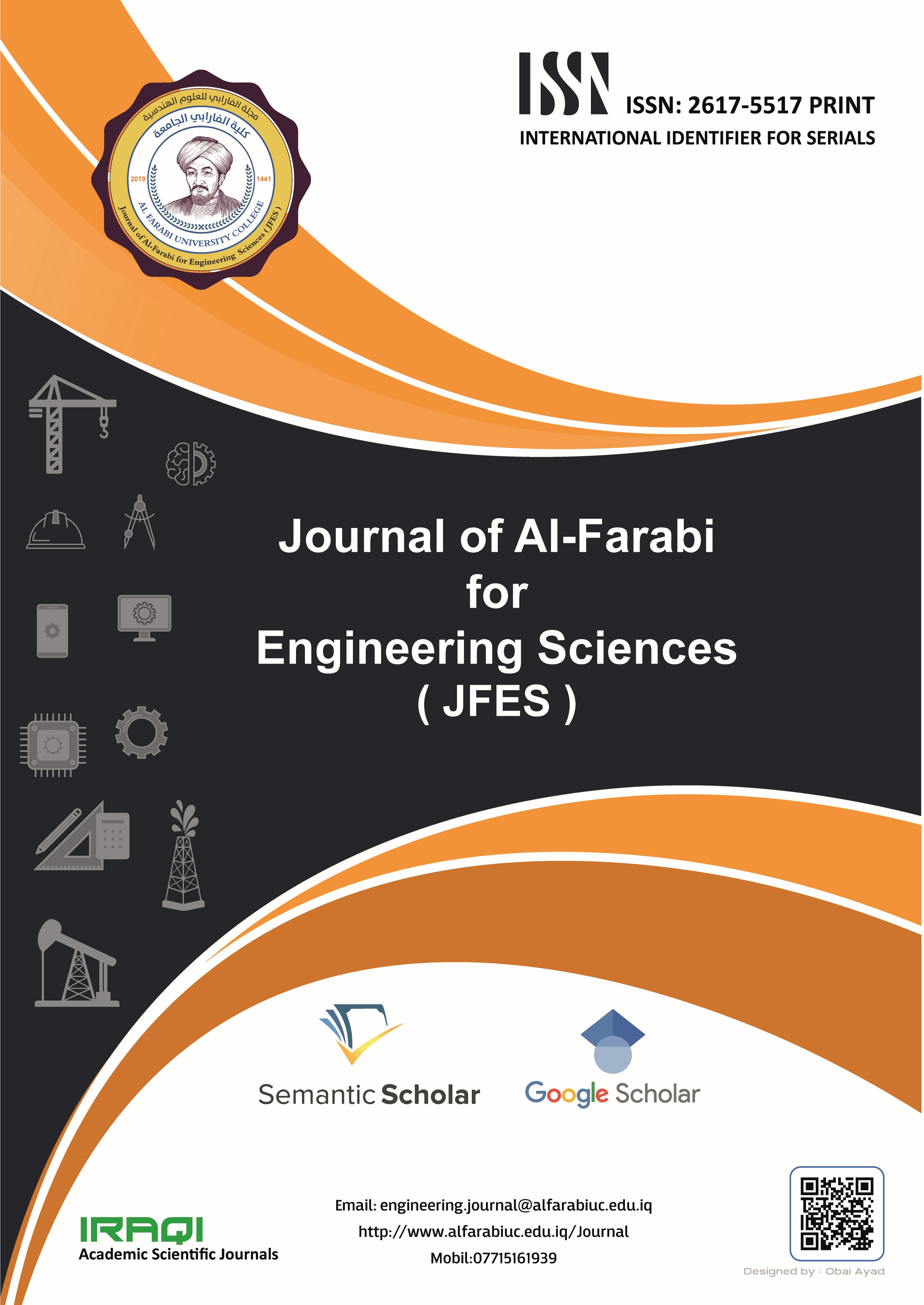Evaluating Urban Thermal Comfort through a Holistic Micro-Climate Model: Baghdad as a Case Study
DOI:
https://doi.org/10.59746/jfes.v2i1.55Keywords:
Thermal Comfort, Green Infrastructure, ENVI-met V4, PETAbstract
Urbanization greatly affects the change in local climate conditions. To address this, urban vegetation needs to be expanded to help dissipate excess heat by promoting evaporation. This study aims to reconnect the urban corridors and spaces of the Al-Mustansiriya region in Baghdad city through a network of green infrastructure (GI), employing the ENVI-MET V4 simulation program, which is a comprehensive micro climate modeling system used to measure and enhance pedestrian comfort levels in an urban environment. The results of the analysis show the significant effect of urban intervention strategies in reducing pedestrian heat stress. Where the air temperature drops by 3-4°C. Furthermore, an association was detected between leaf area density and PET levels. In a broader sense, this research supports the use of ecological urbanization along with integrated urban micro-environment modeling as a catalyst for urban quality improvement.
References
U. Nation, "World Urbanization Prospects 2018: Highlights," Department of Economic and Social Affairs, Population Division, 2019.
L. Schell, M. Smith and A. Billsborough, "Human biological approaches to the study of Third World urbanism," Urban ecology& health, pp. 1-9, 2009. DOI: https://doi.org/10.1017/CBO9780511600494.001
M. G. Flanner, "Integrating anthropogenic heat flux with global climate models. Geophysical Research Letters," vol. 36, no. 2, p. 5, 2009. DOI: https://doi.org/10.1029/2008GL036465
K. Jin, F. Wang, D. Chen, H. Liu, W. Ding and S. Shi , "A new global gridded anthropogenic heat flux dataset with high spatial resolution and long-term time series," Scientific Data, vol. 6, no. 139, p. 14, 2019. DOI: https://doi.org/10.1038/s41597-019-0143-1
CGD, 2019. [Online]. Available: http://www.cgd.ucar.edu (accessed on 16 August 2019).
L. Chengyan and W. Kuan, "Urban Green Space System and Human Settlement Environment Planning," Green Technology, vol. 23, no. 11, 2021.
E. Ng, L. Chen, C. YUAN and Y. Wang, Building and Environment, vol. 47, p. 256–271, 12. DOI: https://doi.org/10.1016/j.buildenv.2011.07.014
D. E. Bowler, L. Buyung-Ali, T. . M. Knight and A. S. Pullin, "Urban greening to cool towns and cities: A systematic review of the empirical evidence," Landscape. Urban Plan, vol. 97, p. 147–155, 2010.
A. Dimoudi and M. Nikolopoulou, "Vegetation in the urban environment: microclimatic analysis and benefits," Energy Build, Special issue on urban research, vol. 35, no. 1, pp. 69-79, 2003. DOI: https://doi.org/10.1016/S0378-7788(02)00081-6
K. Hagen, B. Gasienica-Wawrytko, W. Loibl, S. Pauleit, R. Stiles, T. Tötzer, H. Trimmel, M. Köstl and W. Feilmayr, "Smart Environment for Smart Cities: Assessing Urban Fabric Types and Microclimate Responses for Improved Urban Living Conditions," in Proceedings REAL CORP 2014 Tagungsband, 2014.
M. Bruse, 2015. [Online]. Available: http://www.envi-met.com.
E. Fernández-Juricic, "Spatial and temporal analysis of the distribution of forest specialists in an urban-fragmented landscape (Madrid, Spain): Implications for local and regional bird conservation. Landsc. Urban Plan.," p. 17–32., 2004. DOI: https://doi.org/10.1016/j.landurbplan.2003.09.001
H. Akbari, P. M and H. Taha, "cool surfaces and shade trees to reduce energy use and improve air quality in urban areas," Solar Energy, vol. 70, p. 295–310, 2001. DOI: https://doi.org/10.1016/S0038-092X(00)00089-X
M. Fahmy, S. Sharples and M. Yahiya, "LAI based trees selection for mid-latitude urban developments: A microclimatic study in Cairo, Egypt," Building and Enviroment, vol. 45, p. 345–357, 2010. DOI: https://doi.org/10.1016/j.buildenv.2009.06.014
S. GILL, . J. HANDLEY, . A. ENNOS and S. PAULEIT, "Adapting cities for climate change: The role of the green infrastructure," Built Environment, vol. 33, p. 115–133, 2007. DOI: https://doi.org/10.2148/benv.33.1.115
J. A. Byrne and Y. Jinjun, "Can urban greenspace combat climate change? Towards a subtropical combat climate change? cities research agenda," Australian Planner, vol. 46, p. 36–43, 2009. DOI: https://doi.org/10.1080/07293682.2009.10753420
L. Chen, Y. Wen, L. Zhang and Wei-Ning , "Studies of thermal comfort and space use in an urban park square in cool and cold seasons in Shanghai," Building and Environment, vol. 49, pp. 644-653, 2015. DOI: https://doi.org/10.1016/j.buildenv.2015.10.020
M. R. M. Daneshvar, A. Bagherzadeh and T. Tavousi , "Assessment of bioclimatic comfort conditions based on Physiologically Equivalent Temperature (PET) using the Rayman Model in Iran," Central European Journal of Geosciences, vol. 5, p. 53–60, 2013. DOI: https://doi.org/10.2478/s13533-012-0118-7
Z. R. Abaas, "Impact of development on Baghdad‘s urban microclimate and human thermal comfort," Alexandria Engineering Journal,, p. 16, 2019.
W. N. Hien, "Urban heat island research: Challenges and potential," Frontiers of Architectural Research, p. 276–278, 2016. DOI: https://doi.org/10.1016/j.foar.2016.04.001
F. Salata , I. Golasi, E. D. L. Vollaro, F. Bisegna, F. Nardecchia, M. Coppi, F. Gugliermetti and A. D. L. Vollaro , "Evaluation of Different Urban Microclimate Mitigation Strategies through a PMV Analysis," Sustainability , vol. 7, no. 7, p. 2015. DOI: https://doi.org/10.3390/su7079012
D. E. Bowler, L. Buyung-Ali, T. M. Knight and A. S. Pullin, "Urban greening to cool towns and cities: A systematic review of the empirical evidence," Landscape and Urban Planning, vol. 97, no. 3, pp. 147-155, 2010. DOI: https://doi.org/10.1016/j.landurbplan.2010.05.006




